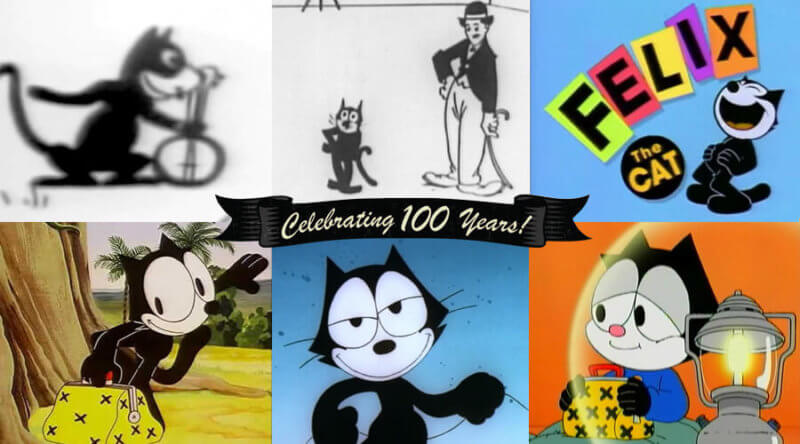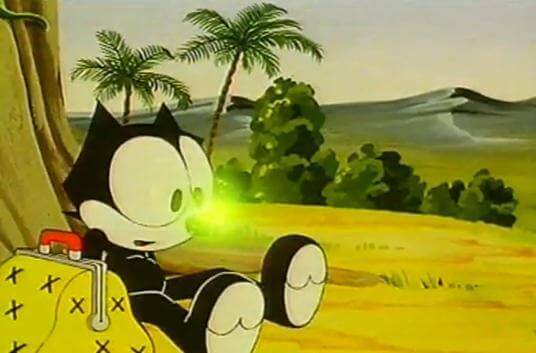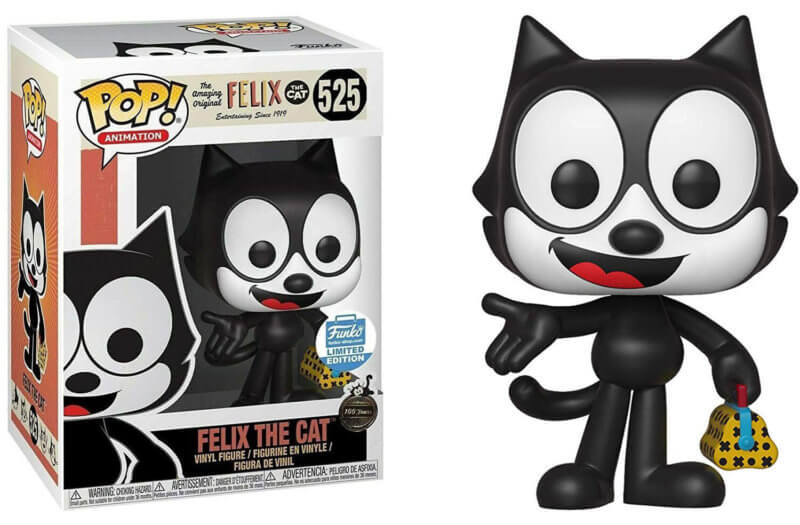Happy 100th Birthday, Felix the Cat!
Nine years before Mickey Mouse and Walt Disney made their theatrical debut in 1928, film-goers were treated to the first of many mischievous and crafty adventures of Felix the Cat during the silent film era. Having gone through many changes and challenges over the past one hundred years, Felix has become an iconic character; despite a fifteen-year absence from the screens where he once starred alongside many animated and Hollywood icons.
To celebrate the one-hundred-year anniversary of the iconic feline, we look back at the highlights and struggles of the character’s presence; both on cinemas screens and home TVs, worldwide.
1910s: The Early Years
Felix the Cat was first introduced in 1919, during the popularity of silent film actors like Charlie Chaplin and May Pickford; performing on the silver screen across the United States. It was in this year that Felix was then known as Master Tom and starred in the short film Feline Follies (1919), before becoming the star in The Musical Mews and The Adventures of Felix within November of that year; leading the way for more animated adventures in the following years.
But who was responsible for bringing the character to life in these classic cartoons in the first place? While Pat Sullivan ran the studio (Pat Sullivan Cartoons) that produced these early short films, there are film historians who believe that an animator in the studio named Otto Messmer was indeed the true creator of Felix. It was Messmer’s animation style – similar to the Charlie Chaplin cartoons that the studio worked on previously -that has convinced animation historians to suggest that he was the one deemed to be the true creator of the character.
1920s to 1940s: Pop Culture Icon
Throughout the remainder of the silent film era, Felix stood strong among the major Hollywood stars of the big screen. Appearing onscreen with the likes of Charlie Chaplin in Felix in Hollywood (1923) propelled him off the screen and into the newspapers as a comic strip, as well as becoming a mascot for the Felix Chevrolet Car Dealership in 1925. He is still being used as the mascot for the same dealership as of writing this article! These ventures into merchandising and branding would make him a recognisable pop culture icon that would continue to build over a span of one hundred years.
But just as Felix was enjoying his fame and success, the Pat Sullivan Cartoons studio ended up struggling to compete with the arrival of the biggest change to cinema since it’s conception: sound.
When Walt Disney’s mouse whistled merrily on his bellowing steamboat in his first on-screen presence, audiences loved the introduction of sound with their moving pictures.
Pat Sullivan, who was the producer at the time, initially refused to produce new content with sound and by the time that he changed his mind, his company would already be at least a year behind Mickey Mouse’s debut. By the time Felix spoke his first words, it was too little too late and it was the first major hit to his popularity.
Although Felix may not have starred in any new short films during the 1940s, he did feature in his own line of comic books from Dell Comics. Written and drawn by Otto Messmer, this would be the only major appearance from the feline after struggling to get studios involved. But with the comic’s success and a new generation of children becoming fans of Felix, he would soon return to the screen; but not in the way Messmer may have thought.
1950s to 1970s: Felix’s TV Debut
Since the 1920s, Felix continued to star in a series of short films as he moved from numerous distributors as the studio experimented with sound, colour and even regular supporting characters who would eventually be forgotten, as years went by without another big screen adventure. But in 1959, he made a comeback; this time in his first televised series!
After Messmer’s retirement in 1954 his assistant, Joe Orilolo, took over the work on the Felix comic books and decided to re-invent and create a television show based around him. Oriolo’s previous success – bringing his co-creation Caspar the Friendly Ghost animated series to screens throughout the fifties – was enough to convince Trans-Lux to come on-board and produce the Felix episodes.
The series made some dramatic inclusions that would become a staple of the character. As well as giving him a fresh re-design that would remain unchanged to this day with his signature laugh, Felix was also given his recognisable magical, yellow bag that he used in every episode to get himself out of many sticky situations and to trick his nemesis, The Professor, while going on adventures with his best friend Poindexter.
This reinvention did prove to be effective as the series featured over one hundred episodes from the tail end of the fifties to the beginning of the sixties. The show also got a fair share of DVD releases in the US and was even given some re-runs in the eighties and nineties. Despite the television series reigniting the character’s popularity, he remained largely absent from the cinema and TV in subsequent years. Despite Joe Oriolo having the rights at this time, nothing was done with the character in the animation industry and it took Joe’s son to change that in the 1980s.
1980s to 2000s: Feature Films & New TV Series
Over twenty-six years passed since the final episode of the television series aired on US television sets and Felix became absent once again. It was Don Oriolo, Joe’s son, who attempted to pull the cat from out of his magical bag in the late eighties, by developing a televised special.
However, it was not until the developing project was taken to Europe and became a multi-national production (involving teams from the USA, Canada, Germany, Hungary, Poland and Bulgaria) that it evolved into the character’s first feature length film – Felix the Cat: The Movie (1988) – with Tibor Hernadi acting as director, after his work as an animator in Hungary. Despite the animation being split across multiple teams in the US, Canada and Europe, the film earned under $2 million in it’s 1989 release, out of its £9 million budget; causing it to both be pushed back and release straight to VHS in 1991.
What followed was a series of bizarre and unusual departures for the character up until his last leading role in 2004. During this period he would be seen with more obscure, darker and over the top adventures that were similar to popular 90’s animation series’ like Rocko’s Modern Life and Animaniacs. The unsuccessful release of the feature film caused the character to return to the small screen with The Twisted Tales of Felix the Cat and much like its title suggests, this was a more mature and edgy take on the character; both artistically and narratively. This series lasted for two seasons, and aired its last episode in 1997.
With the rise of new animated shows that saw iconic characters like Kermit and Bugs Bunny transform into their popular baby counterparts in the likes of Muppet Babies and Baby Loony Tunes from the late eighties to the early noughties, a Japanese studio named Radix teamed up with Don Oriolo’s son to try this unique and popular approach to reviving an older property with Baby Felix. There was only one season of the show produced; made up of twenty-six episodes and eventually forgotten in an over saturated market that was filled with baby and younger versions of classic adult cartoon characters.
Following a second attempt at a feature film, the direct-to-video Felix the Cat Saves Christmas (2004), a new series was touted at the Festival International Du Mervelleux in 2010 by TeamTO. However, this did not go anywhere, despite their success with series’ like Oscar’s Oasis and Angelo Rules.
Despite the struggles of re-creating the huge popularity that Felix once had during the early years of cinema and animation, the character’s face is still widely recognisable a hundred years since his debut. In the past year alone, he has appeared with major names in fashion and was given his first Funko collectible figurine despite a lack of television or theatrical release on the horizons.
No matter what could happen next with Felix the Cat, we know that his struggles and success are one that we can emphasis with, as the many animators and creatives involved have continued to make us laugh and smile through one hundred years of animated whimsy and wonder!





